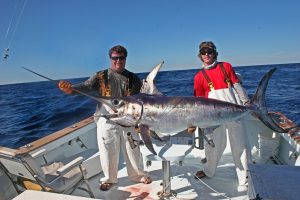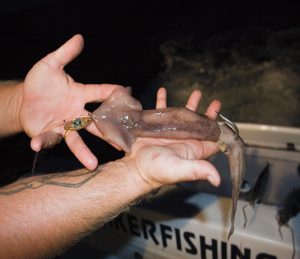March 01, 2017
By Terry Gibson
Where, when and how to fish Swordfish.

You'd think a perennial top-level competitor in bluewater tournaments would be super-secretive. Not Capt. Pat Price, owner of Daymaker Charters in Stuart. Raised on the water by a father and uncles who fished for a living in this fertile area, Pat is a born teacher who loves to exchange ideas about rigging baits and about the ocean itself. Hardly a week goes by when he isn't giving a seminar at a local shop, and if you charter him he prefers to make the experience instructive and interactive.
When Pat offered to show me some quick and easy rigs for nighttime swordfishing, friend Tom Wheatley and I gladly volunteered as crew on his 34 SeaVee. Rigging baits for the evening, Price discussed his favorites: squid, bonito, large tinker mackerel, Boston mackerel and mullet. It helps to put out a combination of these baits unless the bite is hot and the fish demonstrate a clear preference.
“I prefer to start with a couple different varieties of weight, depth, light colors, weights or no weights, then replicate what worked,” says Price.

Easy Squid Rig
Like many Florida experts, Price agrees that it's best to appeal to as many of a swordfish's senses as possible. Squid are a leading if not the top component of a swordfish's diet. Plus, squid stinks and leaves a powerful scent trail in the water.
The terminal tackle consists of a Mustad offset J-hook crimped to 12 feet of 300-pound pink Prime Line. This line is stiff, which helps the bait action and the pink seems to be less visible around the lights.
The length of the squid determines the number of luminous beads you will use, but for a fairly large squid put three chartreuse beads above the crimp, and then add a 3/4-ounce egg weight. Place two more beads above the weight, to prevent the bait from sliding down the hook. It's important to keep the weight above most of the beads, to offset the weight of the hook, or the squid will dangle in an unnaturally vertical position. You want the bait to undulate horizontally.
The beads serve a dual purpose: They keep the bait swimming seductively and reflect light so that the squid appears to glow, as feeding squid do at night.
The best way to rig a squid is to stitch it on the line, which keeps the bait from sliding down over the hook and interfering with the hookset. But stitching is more complicated, and beginners may want to start with the following rig:
First, place the squid dorsal side down and measure the hook, bead and sinker against its length to ensure that the hook will emerge exactly between the squid's eyes. Starting roughly between the squid's eye, insert the leader into a piece of copper tubing or hollow stainless tubing, and run it up from inside the mantle, and through the point. This tubing should be just barely large enough in diameter to allow the line to slide through, or you'll create a hole large enough that the bait slides back on the hook. Pull the leader, beads and weight into the squid until you have the proper angle to push the hook back down through the head and out between the eyes.
“Because the hook is offset, you need to take your time and make sure the hook comes through the center,” Price cautions. “Otherwise, your bait will spin.”
In terms of appealing to a sword's giant eye, Pat isn't satisfied by the reflection of ambient light and glow sticks off the beads inserted in the squid. He swears by the light attractors made by Esca. The small lights come in blue or green--light wavelengths that simulate lure lights used by marine organisms such as squid. These bands in the color spectrum penetrate farthest in water; meanwhile the unit emits an electronic signal that fish may detect via their lateral line. Slide the leader through the two rings and let the light slide down against the squid. The attractors operate chemically and are activated upon contact with salt water, so they require no batteries. They're reusable, offer up to 100 hours advertised life, and are guaranteed down to depths of 1,000 meters. They work well for daytime swordfishing, as well. Visit escaglobal.com.
Mackerels, Small Bonito and Mullet

Fresh is best, but you can purchase Boston mackerel by the pallet in just about any bait store. But many guides prefer fresher baits. In the Keys, tinker mackerel are easy to catch and popular. Mullet are caught fresh easily and often preferred by Palm Beach and Treasure Coast swordfish diehards.
“I like mullet because we can get them fresher, because they are shinier, and because they have scales,” says Price. “If a fish swings and misses, it still puts a lot of scales in the water to trigger a secondary bite or attract a second fish to bite.”
Terminal tackle includes the same offset J-hook crimped to 300-pound mono leader. You can also sew a chin weight onto the baits for added depth and action in heavier seas.
Whether you're using mackerels or a wedged and deboned mullet, you need to keep the bait stiff to keep it from collapsing when a fish strikes. Bamboo skewers sold at grocery stores do the trick. Trim the skewer to match the length of the fish's body, not including the tail. Stuff it down the bait's throat and along the backbone.
Price says, “Remember, you're drifting. A dead, flexible bait won't give the appearance of a stunned fish. But a stiff bait will dart side to side in the water as the waves move the line, lead and balloon.”
Next, close the mouth and then the gills with a rigging needle and floss. After that, diamond-stitch the bait down and back beginning through the eye socket. Stitch the hook to the head. You can either put the hook vertically through the fish's head, or take the time to stitch it through the head, which will result in more hookups.
When to Go
Price's favorite moon phases include the three days leading up to the full moon and then the few days following the full moon. Fishing on the day of the full moon tends to result in hits right at sundown and at sunrise, with little action in between.
It's a good idea to leave well before sundown and to look for rips and weedlines between 1,200 and 1,800 feet or even deeper. These rips are often formed by thermoclines, which result in concentrations of bait. Also, fish around structure in those depths. Past dark, bioluminescence is a dead giveaway that bait is in the area. Look also for thermoclines, which show up as fuzzy or thick lines across the screen depending upon their intensity.
“Put a bait below the thermocline, in it, and above it, then adjust from there until you get a strike,” advises Price.
Plan your drift to finish fishing right off your home inlet, if you can. Along the southeast Florida coast, the typical current is 2 to 3 knots to the north. Figure on multiplying the number of hours you want to fish by the current speed and start that far south of home in the aforementioned depth range. Don't forget that a hard east or west wind will push you across depth zones.
Deploying Baits
Hang a blue, green or purple Hydroglow or Sword Light off the side of the boat.
By fishing a light off the side of the boat, you can jig for squid and tinker mackerel for baits. It's a form of entertainment but also extremely effective at increasing your chances of catching a fish. The attraction of the light provides instant live chum around your vessel.
Price likes to fish three baits under balloons and one right off the rodtip. Twenty-foot wind-on leaders follow the 12-foot mono shock section. Weights and lights are attached about 30 feet above the wind-on leaders on breakaway systems. Some of the bigger lights have clips for weight attachment. You want to lose that weight or it may pull the hook, or create safety issues around the boat when the fish comes boatside.
The balloons separate the baits, and are illuminated by glow sticks attached with electric tape. The balloons are attached to the main line by wax loops or rubber bands. Put the deepest line out the farthest and deploy it first. And put the light color that is easiest to see on that balloon. Your rods should be “color-coded.” Easy to see, usually green, is the long rod. Red might be the middle, and blue the short. Keep in mind you have a ton of slack to deal with in these rigs, and if a fish takes the bait and/or swims toward the surface, the only sign of a strike may be that the balloon is lying sideways. When in doubt, reel like mad.
